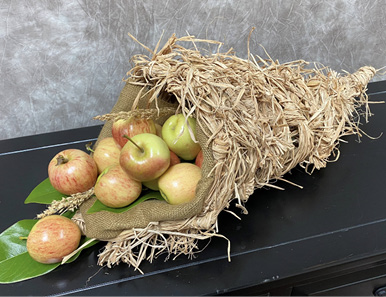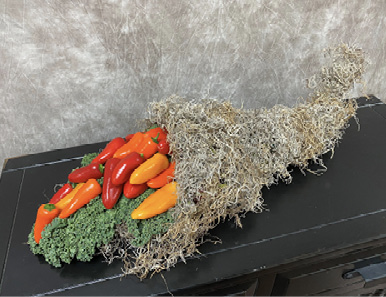Cornucopia for Floral Designs
The cornucopia, or horn of plenty, is an exuberant decorative motif fitting for the harvest season. Its form allows it to overspill with the bounty of the harvest. Many people associate the horn of plenty with the Thanksgiving holiday, but its roots date back much further than the early observances by European settlers in modern Virginia and Massachusetts.
The word itself combines two Latin words, cornu (horn) and copiae (plenty). It is a symbol of abundance and blessings. The American Institute of Floral Designers Guide to Floral Design defines it as:
A container, often a basket, shaped like a goat’s horn or cone, typically filled and overflowing with fruits, flowers, foliage, and/or grains.
The word cornucopia may have originated from Greek mythology, referring to the horned goat Amalthea that nursed baby Zeus or Jupiter. The symbol of plenty was used to depict fertile regions on maps and prosperous countries in art through the modern era.
It is appropriate to use this symbol in the places where people live, work, dine, and congregate because it reminds us to be thankful and grateful for the fruits of the earth. In floral design, we tend to assign the cornucopia to Thanksgiving tables because of its association with the harvest. But let’s rethink this practice and consider it for decoration throughout the year!
It is possible to purchase premade basket cornucopias, but they can be challenging to find, and the selections of sizes and finishes are often limited. This publication offers a variety of cornucopia designs that you can make yourself. We developed these projects for all levels of floral designers.
The first three designs are variations on the same foundation. They were each constructed using 12-by-12-inch squares of chicken wire. We folded the wire into a funnel form, then used the loose wires to bind and hold it in shape.
Green Cornucopia

We used hot glue to adhere florist sheet moss to the wire funnel form. We wanted to use greenery from the yard to complete the design, so we selected a container filled with fresh flower foam for the mechanic.

Fresh foliage materials include camellia and ivy foliage, along with a few succulent sedum.

This arrangement has a long display life. Cut flowers can be added to the foam but are not necessary since the foliage arrangement is interesting and trendy.

Raffia Cornucopia
We individually knotted small bundles of raffia, about 15 pieces per bunch, then wound and glued them to the wire form. We lined the cone with burlap to finish the interior. We liked how the loose ends of the raffia looked like straw, so we left them in place to keep the rustic theme and cut down on labor time.

A market bag of apples and some magnolia leaves from a nearby tree create a nice contrast of textures. If you used this design at a farmers market to display fruit, many customers would buy the entire presentation!

Spanish Moss Cornucopia
In this example, Spanish moss covers the horn-shaped chicken wire form. If you do not have access to glue from a pan, you can use a hot glue gun. We tucked extra moss in the cornucopia to cover exposed wire.

Note that we bent the pointed end of the horn into an upright curve. We purchased a bag of these colorful sweet peppers at the market and placed them atop a bed of fresh kale. Your cornucopia design can influence your menu, and vice versa!

We overwrapped the same Spanish moss cornucopia with decorative bullion wire, a light-gauge, sparkling wire, to help keep the moss in place and make it more resistant to weathering. We created a nosegay of silk flowers and wired it into the basket, then added a bit of ribbon to create a door decoration. Think “springtime bounty”!

Corkscrew Willow and Sisal Wire Cornucopia
The next cornucopia example uses a chicken wire frame, but it is slightly larger and drawn to a long point. We wanted to create a basket with an elongated tail, adding more character and size to the design. We used corkscrew willow and sisal-covered wire to cover the frame. Because these two materials are wispy and thin, they do not cover the funnel’s surface area quickly, so this design required more time to create.

The willow and sisal allowed us to make the horn of plenty’s tail long and slender. This feature gives the basket rhythm, a design principle denoting a sense of movement. Note that we added green excelsior, a moss-like fiber, in the frame’s open voids to help disguise the wire netting.

We placed a glass bubble vase inside the basket’s lip, then added a market bunch of tulips. Be sure that the cut ends of the stems are in water and that the line of the design is elongated to continue the horn’s long, low profile. For flair, we added a stem of plumosa fern hovering over the flowers.

Midollino Cornucopia
This cornucopia uses only midollino (wicker) sticks and paper-covered wire. First, we created concentric circles of the sticks as frame supports, then wove extra midollino through them to create a light, lacy basket. Use plenty of the sticks and paper-covered wire to create a horn that holds together. The idea in this design is that the cornucopia is very light in appearance, merely suggesting the horn of plenty shape.

The finished horn holds a few cones and evergreens from the nearby woods. The circular pods are the dried fruit from water lily plants, also known as lotus, and we purchased these at a local craft store.

Poole Moss Cornucopia
This cornucopia, constructed by Mississippi artisan David Mills, uses a heavy chicken wire frame covered in yellow-green tinted poole moss. It is approximately 30 inches long by 18 inches wide.

We used fresh flower foam mechanics and filled the design with a seasonal assortment of hydrageas, roses, stock, snapdragons, and tulips. This design would be spectacular for an Easter buffet or springtime event.
References
Boramund, S. (2018). Cornucopia: Origins, diffusion, and adoption in ancient Irano-Indian semiosphere. Studies in People’s History, 5(2), 166–179.
Dole, J., Stamps, R., Carlson, A., Ahmad, I., Greer, L., & Laushman, J. (2017). Postharvest handling of cut flowers and greens: A practical guide for commercial growers, wholesalers, and retailers (1st ed.). Association of Specialty Cut Flower Growers.
Hunter, N. (2013). The art of floral design (3rd ed.). Delmar.
Johnson, J., McKinley, W., & Benz, B. (2001). Flowers: Creative design. San Jacinto.
McKinley, W., Cravens, L., DelPrince, J., Scace, P., Gallagher, J., Jaras, J., & McGukin, S. (Eds.). (2022). The AIFD guide to floral design. Schiffer.
Patton, P. (2019, November 18). Digging into the horn of plenty. The Index of Medieval Art.
Scace, P., & DelPrince, J. (2021). Principles of floral design (2nd ed.). Goodheart-Willcox.
Stewart, M. (2020, July 6). How to make a handmade cornucopia for a festive fall centerpiece. Martha Stewart.
Special Thanks
Floral enthusiasts have so many reasons for giving thanks. We at MSU Extension wish to express our gratitude to flower growers, shippers, retailers, consumers, and especially our MSU Extension Master Floral Designer and Professional Florist program students and participants.
Special thanks to the following people for their support in the development of this publication:
Andrea Osman for reminding the author of the beauty of a cornucopia centerpiece.
Dr. Joy Fox Anderson and Lara Savage Angel, MSU Extension agents in DeSoto County, for suggesting the recognition of Thanksgiving in our floral design program.
David Mills, The Nature of Things, Courtland, Mississippi, for providing the poole moss cornucopia.
Publication 3792 (POD-07-22)
By James M. DelPrince, PhD, AIFD, PFCI, Associate Extension Professor, Coastal Research and Extension Center.
The Mississippi State University Extension Service is working to ensure all web content is accessible to all users. If you need assistance accessing any of our content, please email the webteam or call 662-325-2262.


